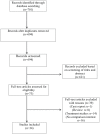Involvement of cervical disability in migraine: a literature review
- PMID: 34055341
- PMCID: PMC8138615
- DOI: 10.1177/2049463720924704
Involvement of cervical disability in migraine: a literature review
Abstract
Background: The trigeminal nerve theory has been proposed as a pathophysiological mechanism of migraine; however, its association with the triggers of migraine remains unclear. Cervical disability such as neck pain and restricted cervical rotation, have been associated with not only cervicogenic headaches but also migraine. The presence of cervical disability could worsen of the migraine, and also the response to pharmacologic treatment may be reduced. The aim in this review is to highlight the involvement of cervical disability in migraine, considering contributing factors.
Findings: In recent years, evidence of neck pain complaints in migraine has been increasing. In addition, there is some recent evidence of cervical musculoskeletal impairments in migraine, as detected by physical assessment. However, the main question of whether neck pain or an associated cervical disability can act as an initial factor leading to migraine attacks still remains. Daily life imposes heavy loads on cervical structures (i.e. muscles, joints and ligaments), for instance, in the forward head position. The repetitive nociceptive stimulation initiating those cervical skeletal muscle positions may amplify the susceptibility to central migraine and contribute to chronicity via the trigeminal cervical complex.
Conclusion: Further studies are needed to explain the association between cervical disability as a source of pain and the development of migraine. However, evidence suggests that cervical disability needs to be considered in the prevention and treatment of migraine.
Keywords: cervical disability; migraine; neck pain; trigeminal cervical complex.
© The British Pain Society 2020.
Conflict of interest statement
Conflict of interest: The author declared no potential conflicts of interest with respect to the research, authorship and/or publication of this article.
Figures
Similar articles
-
Cervical mobility in women with migraine.Headache. 2009 May;49(5):726-31. doi: 10.1111/j.1526-4610.2008.01233.x. Epub 2008 Sep 9. Headache. 2009. PMID: 18783446
-
Are There Gender Differences in Neck Pain and Musculoskeletal Disorders of the Cervical Spine Associated with Migraine?Pain Med. 2021 Dec 11;22(12):3021-3029. doi: 10.1093/pm/pnab106. Pain Med. 2021. PMID: 33739397
-
Head pain referral during examination of the neck in migraine and tension-type headache.Headache. 2012 Sep;52(8):1226-35. doi: 10.1111/j.1526-4610.2012.02169.x. Epub 2012 May 18. Headache. 2012. PMID: 22607581
-
Cervical musculoskeletal impairments in migraine and tension type headache: A systematic review and meta-analysis.Musculoskelet Sci Pract. 2019 Jul;42:67-83. doi: 10.1016/j.msksp.2019.04.007. Epub 2019 Apr 25. Musculoskelet Sci Pract. 2019. PMID: 31054485
-
Which Examination Tests Detect Differences in Cervical Musculoskeletal Impairments in People With Migraine? A Systematic Review and Meta-Analysis.Phys Ther. 2019 May 1;99(5):549-569. doi: 10.1093/ptj/pzz007. Phys Ther. 2019. PMID: 30690564
Cited by
-
OnabotulinumtoxinA Treatment in Chronic Migraine: Investigation of Its Effects on Disability, Headache and Neck Pain Intensity.Toxins (Basel). 2022 Dec 30;15(1):29. doi: 10.3390/toxins15010029. Toxins (Basel). 2022. PMID: 36668849 Free PMC article.
-
Myofascial trigger points therapy increases neck mobility and reduces headache pain in migraine patients - pilot study.BMC Musculoskelet Disord. 2025 Feb 1;26(1):105. doi: 10.1186/s12891-025-08360-1. BMC Musculoskelet Disord. 2025. PMID: 39893364 Free PMC article. Clinical Trial.
-
General physical impairments in migraine patients beyond cervical function.Sci Rep. 2024 Dec 28;14(1):30916. doi: 10.1038/s41598-024-81841-w. Sci Rep. 2024. PMID: 39730625 Free PMC article.
References
-
- Sjaastad O, Saunte C, Hovdahl H, et al.. ‘Cervicogenic’ headache. An hypothesis. Cephalalgia 1983; 3: 249–256. - PubMed
-
- Sjaastad O. Cervicogenic headache: the controversial headache. Clin Neurol Neurosurg 1992; 94(Suppl.): S147–S149. - PubMed
-
- Amiri M, Jull G, Bullock-Saxton J, et al.. Cervical musculoskeletal impairment in frequent intermittent headache. Part 2: subjects with concurrent headache types. Cephalalgia 2007; 27(8): 891–898. - PubMed
-
- Bakal DA, Kaganov JA. Muscle contraction and migraine headache: psychophysiologic comparison. Headache 1997; 17: 208–215. - PubMed
-
- Blau JN, MacGregor EA. Migraine and the neck. Headache 1994; 34: 88–90. - PubMed
LinkOut - more resources
Full Text Sources


